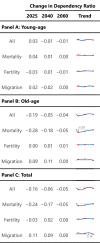Projecting the long-term effects of the COVID-19 pandemic on U.S. population structure
- PMID: 38499539
- PMCID: PMC10948855
- DOI: 10.1038/s41467-024-46582-4
Projecting the long-term effects of the COVID-19 pandemic on U.S. population structure
Abstract
The immediate, direct effects of the COVID-19 pandemic on the United States population are substantial. Millions of people were affected by the pandemic: many died, others did not give birth, and still others could not migrate. Research that has examined these individual phenomena is important, but fragmented. The disruption of mortality, fertility, and migration jointly affected U.S. population counts and, consequently, future population structure. We use data from the United Nations World Population Prospects and the cohort component projection method to isolate the effect of the pandemic on U.S. population estimates until 2060. If the pandemic had not occurred, we project that the population of the U.S. would have 2.1 million (0.63%) more people in 2025, and 1.7 million (0.44%) more people in 2060. Pandemic-induced migration changes are projected to have a larger long-term effect on future population size than mortality, despite comparable short-term effects.
© 2024. The Author(s).
Conflict of interest statement
The authors declare no competing interests.
Figures





References
-
- National Center for Health Statistics (NCHS), COVID-19 Mortality Overview (2022).
-
- E. Arias, B. Tejada-Vera, K. Kochanek, F. Ahmad, “Provisional Life Expectancy Estimates for 2021” (National Center for Health Statistics (U.S.)) 10.15620/cdc:118999 (2022).
-
- M. Osterman, B. Hamilton, J. Martin, A. Driscoll, C. Valenzuela, “Births: Final Data for 2020” (National Center for Health Statistics (U.S.)) 10.15620/cdc:112078 (2021). - PubMed
-
- M. Osterman, J. K. B. Hamilton, E. J. A. A. Driscoll, C. Valenzuela, “Births: Final Data for 2021” (National Center for Health Statistics (U.S.)) 10.15620/cdc:122047 (2023). - PubMed
MeSH terms
Grants and funding
- RC-2018-003/Leverhulme Trust
- RC-2018-003/Leverhulme Trust
- RC-2018-003/Leverhulme Trust
- RC-2018-003/Leverhulme Trust
- ERC-2021-CoG- 101002587/EC | EU Framework Programme for Research and Innovation H2020 | H2020 Priority Excellent Science | H2020 European Research Council (H2020 Excellent Science - European Research Council)
- ERC-2021-CoG- 101002587/EC | EU Framework Programme for Research and Innovation H2020 | H2020 Priority Excellent Science | H2020 European Research Council (H2020 Excellent Science - European Research Council)
- Advanced Grant CHRONO 835079/EC | EU Framework Programme for Research and Innovation H2020 | H2020 Priority Excellent Science | H2020 European Research Council (H2020 Excellent Science - European Research Council)
LinkOut - more resources
Full Text Sources
Medical

